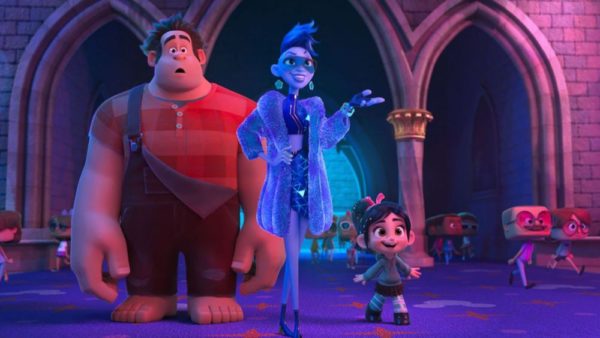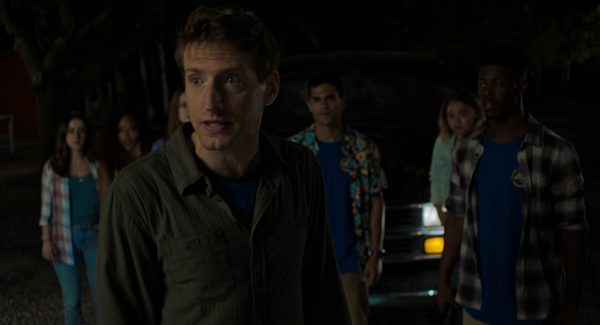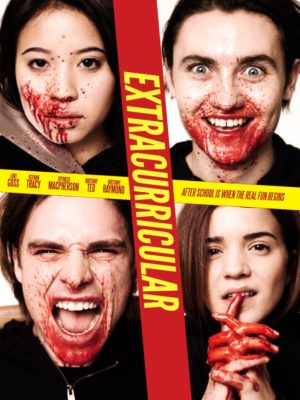
TIFF 2019
In 2019, my (non-genre) Toronto International Film Festival coverage included reviews at The Spool and Consequence of Sound. [Read more…]
The curated portfolio of film journalist Joe Lipsett
by Joe Lipsett

TIFF 2019
In 2019, my (non-genre) Toronto International Film Festival coverage included reviews at The Spool and Consequence of Sound. [Read more…]
by Joe Lipsett

The Mastercard Off-Camera Film Festival is one of the largest festivals in Eastern Europe, running annually for approximately 10 days in late April. This year I had the pleasure of attending the fest when it ran from April 26 – May 5. Taking place in Krakow, the beautiful cultural capital of Poland, the 12th iteration of the festival was divided into several different sections, including:
Film Reviews

Polish Feature Film Competition
I split my time between two sections: the Main Competition and the Polish Feature Film Competition. I made a deliberate attempt to seek out the Polish films in particular because I was uncertain how many of them would be able to secure international distribution.
One fascinating film was Ciemno, Prawie Noc / Dark, Almost Night (Lankosz, 2019), a moody thriller that’s a cross between The Girl With The Dragon Tattoo and HBO’s Sharp Objects. The film, an adaptation of Joanna Bator’s well-known Polish novel of the same name, follows reporter Alicja (Magdalena Cielecka) as she returns home for the first time in years in the wake of her abusive childhood (revealed slowly in nightmares). Alicja has chosen to return at this particular moment in order to investigate a series of child abductions, but there’s a great deal more to the crimes, her own story and the town than meets the eye.
Dark, Almost Night is not a perfect film, in that it frequently struggles to balance Alicja’s backstory with the strange events occurring around town. The film is overstuffed with characters and subplots, including a group of mysterious cat-women, Nazis, and Alicja’s mysterious neighbour and his shady nephew, the latter of which Alicja begins sleeping with. I was amazed to learn after the screening that the film actually excises a great deal of the book’s content because it already feels like it’s bursting at the seams!
Still, there’s something incredibly evocative about the sumptuous visual aesthetic of the film, which walks a razor’s edge between adult fairytale and dark crime thriller. The film is certainly not for the faint of heart: there is a great deal of child abuse, rape and murder, but the grim and fatalistic tale is never boring and it is frequently gorgeous to look at. The subject matter alone makes me doubt whether the film will find North American distribution, but if mystery and thriller fans can ever lay eyes on it, Dark, Almost Night is worth checking out.
No less ambitious, but even more confronting, is Jagoda Szelc’s second film, Monument (2018). The film, which doubles as a thesis project for real life actors graduating from the National Film School in Łódź, is an intersection between a workplace drama and Lynchian nightmare.
Monument follows a group of hospitality students completing an internship in a rundown hotel who are put through their paces by a severe authoritarian manager, but the film eschews a straightforward narrative in favour of monotonous, repetitive and surreal sequences that hint at there is something more nefarious and otherworldly.
Playing out like a waking dream, Monument boasts outstanding visual sequences and incredible sound design, but the experimental (occasionally non-sensical) plot and philosophical diatribes will undoubtedly turn off a mainstream audiences. Personally I loved the film’s audacity, particularly Szelc’s pre-screening video introduction, where she encouraged audiences to avoid resisting or unpacking the film in favour of simply letting go, accepting the confusion and acknowledging different interpretations. Not every director has the gumption, but Monument wears its ambition on its sleeve, and for that it and Szelc deserve recognition. Of all of the films that I saw at Off Camera, this is one of two films that I really hope gets distributed in North America.
Making Way Main Competition Films
While Sons of Denmark took home the biggest prize of the festival, it was by far my least favourite of the four Making Way films that I watched (in brief: the first half is great and then it falls into hysterical melodrama and the resolution is laughable and desperate to solicit an emotional reaction). It’s disappointing considering the other three films were far superior, including the one Polish film in contention, Adrian Panek’s Wilkolak / Werewolf (2018).
https://www.youtube.com/watch?v=ZKbQxP76KWw
Comparing the film to Lord of the Flies diminishes the achievement of this post-WWII film about a group of orphans who are liberated from the concentration camps and left to their own devices at a mansion in the woods. There’s a great deal more going on that than a simple redux of Golding’s “children forming their own society” narrative.
Werewolf quietly tackles a little known piece of history while crafting a smart, frequently nail-biting narrative of children imprisoned in a decaying manor by a pack of blood-thirsty, Nazi-trained dogs living in the wild. The performances are uniformly excellent, particularly Sonia Mietielica as Hanka, the defacto “adult” of the group who is required to parent the others against her will because she is the oldest.
Bonus points for making the dogs legitimately terrifying without resorting to CGI. I wouldn’t recommend this film to anyone with a prevailing fear, however; you may never pet another stray again.
Another unnerving thriller is Swiss film Der Laufer / Midnight Runner (Baumgartner, 2018). Terrifyingly based on real events, the film follows Jonas Widmer (Max Hubacher), an Olympic running hopeful whose late night runs are secretly escalating from low level attacks on random women into something much, much darker.
Baumgartner structures the first part of the film in a deliberately confusing fashion so that it is unclear when events are happening, including the death of Jonas’ beloved brother and a crushing second place finish in a significant race. Unable to process his emotions, or confide in his well-meaning girlfriend, Jonas begins running late at night. One night he tries to help a woman who has tripped on the sidewalk, but when she berates him, he impulsively steals her purse. From there the aggression and violence of his late-night attacks escalate, affecting his relationship and his training, even as Jonas struggles to understand or control his own actions.
It’s an amazing lead performance by Hubacher, who manages to engender both sympathy for Jonas as well as condemnation for his increasingly despicable acts. Midnight Runner is a great, albeit difficult film that perfectly encapsulates the systemic dangers of toxic masculinity, entitlement and the justifiable fear that women have of men.
The single best film that I saw at Off Camera was Dronningen / Queen of Hearts (el-Toukhy, 2018). The Danish/Swiss co-production is about Anne (Trine Dryholm), a high profile lawyer with a seemingly perfect family who torpedos her entire life when she begins sleeping with her troubled stepson, Gustav.
Queen of Hearts is a character study of an impulsive, extremely intelligent woman. Anne knows what she is doing is wrong because she not only hides her infidelity, but she literally works exclusively on cases of child endangerment at her legal practice. Dryholm is absolutely phenomenal in the lead role: her Anne is complicated, messy and horrible and the drama she wreaks as a result of her selfish actions is compulsively watchable. The fact that el-Toukhy and co-screenwriter Maren Louise Käehne lean into the moral murkiness and allow the story to play out without condemnation or judgment speaks to the confidence of the filmmaking on display. Queen of Hearts definitely isn’t a feel good story, but I loved every second of its terribleness and I can’t wait for the film to break out as it continues to play the festival circuit.
Festival News
This year the Off Camera festival office took up a new residence just off of the historical town square in downtown Krakow. While the newer, more modern interior hall doesn’t have the same patio and old world charm as its predecessor, the larger size is roomier and more accommodating for guests, which is a welcome change when you’re rubbing elbows with the cream of the Polish film industry crop during the industry parties each night.
In addition to film screenings and industry social opportunities, the festival also offers workshops, panel discussions and networking events designed to bring together individuals working in the film industry. At one of the networking event, I learned that the Off Camera Foundation is running a project, funded by the EU, called “Film In Malopolska” through June 2019. The project centers on the promotion of small and medium-sized productions in the region in both domestic and foreign markets, marketing Malopolska as an ideal region for film productions. Attendees at the event hinted that entrepreneurs in the film industry plan to take advantage of the program, which should bring even more productions to the Malopolska region in the near future.
Finally, as a first time attendee of the festival, one of the most impressive features that I want to highlight is Festival TV, a news feature that is updated daily and run in front of film screenings. The ~5-7 minute promo features notable items from the previous day, including interviews with directors and industry panels and footage from the live musical acts that perform nightly, as well as previews of what audiences can expect the following day. It’s a professionally produced piece of news entertainment that keeps the festival feeling fresh each day. It also demonstrates the level of time and investment that staff are putting in to make the experience of festival goers memorable and engaging. Other festivals could learn a thing or two about such ambitious efforts.
The Off Camera Film Festival runs each April in Krakow, Poland. For more information, visit the festival website here.
by Joe Lipsett

My podcasting partner, Brenna Clarke Gray, and I record a weekly podcast called Hazel & Katniss & Harry & Starr, which dissects young adult literature, their filmic adaptations and everything in between. The podcast also has a mandate to highlight Canadian literature and Canadian writers. Podcasts are broken into three categories:
1. Chapters: These full-length episodes focus on a young adult book and its corresponding film or television show adaptation.
Book Two
Book One
 2. Appendixes: These mini bonus episodes range in content. Typically they offer a forecast of notable seasonal or upcoming titles, or a select one-off topic for discussion that falls outside of the guidelines of a Chapter, such as:
2. Appendixes: These mini bonus episodes range in content. Typically they offer a forecast of notable seasonal or upcoming titles, or a select one-off topic for discussion that falls outside of the guidelines of a Chapter, such as:
 3. Excerpts: These mini bonus episodes are interviews conducted with Canadian YA authors discussing one of their most popular or celebrated texts. Typically one episode is released each month:
3. Excerpts: These mini bonus episodes are interviews conducted with Canadian YA authors discussing one of their most popular or celebrated texts. Typically one episode is released each month:
by Joe Lipsett

In both the real world and the filmic world, six years have passed between adventures for Wreck It Ralph‘s titular character (John C. Reilly) and his pint-sized bestie, Vanellope (Sarah Silverman). It hardly matters whether viewers retain any specifics about the duo’s first outing; although Ralph offers a brief recap, audiences need only recall that friendship is the defining aspect of their relationship, so much so that Vanellope had the words “You’re My Hero” emblazoned on a commemorative medal that Ralph wears around his neck. [Read more…]
by Joe Lipsett

While Kevin Williamson and Wes Craven certainly didn’t invent the self-referential horror film, due to its pop culture footprint Scream has become a natural point of comparison for every post-1996 metatextual horror film. More than twenty years ago Sidney Prescott and Ghostface grossed $100M+ and, in the process, redefined the way that audiences — and filmmakers — considered how horror films are constructed. The proliferation of self-aware horror films in the 00s and 10s reflects this change (for better or worse) as it is now considered fair game to have characters acknowledge their predicament with a knowing wink to the audience, even while they run around screaming and dying.
Enter Brett Simmons‘ new horror-comedy, You Might Be The Killer, a film that gleefully comments on the tropes of the first cycle of 80s slasher films, even as it aims to replicate them, all while adopting an intriguing non-linear narrative structure that jumps back and forth in time. Although the film fails to stand on its own two feet by offering something new and unexpected, writers Simmons, Thomas P. Vitale and Covis Berzoyne do a good job of constructing a film that honours the conventions of the subgenre while simultaneously referencing and abiding by them.
You Might Be The Killer begins in media res as camp director Sam (Fran Kranz) calls his best friend Chuck (Alyson Hannigan) in the middle of a massacre. He quickly explains that the majority of the camp counsellors have been murdered by a bone-machete wielding masked man and that he has barricaded himself inside a cabin in the hopes of staying alive. Chuck is a video store employee and Sam’s go-to horror movie expert so he enlists her help in figuring out how best to survive. Thus begins a loose sort of bracketing device in which Chuck asks Sam questions to uncover the events that unfolded, which prompts the narrative to double back on itself (often using a title card indicating the number of dead counsellors to help audiences keep track of the timeline).
Although the film initially plays up the mystery of the killer’s identity, the film’s title a dead giveaway as to who is responsible. After a brief period, Simmons, Vitale and Berzoyne lay their cards on the table and acknowledge that Sam has been murdering his employees in a kind of fugue state; at this point the focus of You Might Be The Killer shifts from the mystery of “who” is the killer to the “why” the murders are happening, as well as “how” Sam can survive his situation. Throughout this process, Chuck reiterates the rules of the slasher genre according to its most popular entries (all while impressively manning the register and sassing customers who eavesdrop of the phone call).

Despite its meta elements, I would argue that the closest comparable film is not Scream, but 2015’s The Final Girls. Both films gently mock and play with the conventions of the slasher film while stringently adhering to them. Admittedly The Final Girls has a great deal more heart (and gender politics) working in its favour, but both films are fun, spirited endeavours that have a breezy vibe to them, thanks to a winsome cast.
The success of You Might Be The Killer is 100% thanks to Kranz and Hannigan. The two actors bring a great deal of audience goodwill from their various Joss Whedon projects to the production and their warm, empathetic screen presence helps engender audience investment. Even after it is revealed that Sam is the killer, Kranz manages to make him sympathetic and likeable. Hannigan arguably has the more challenging role of the two, given that she is divorced from all of the action; even stranded in a single video store set and forced to act all of her scenes on the phone, she’s a sheer delight. She infuses Chuck’s know-it-all, chipper, informative exposition with charm, easily making Chuck one of the highlights of the film.
Alas, despite the two strong performances anchoring the film, You Might Be The Killer peters out around the one hour mark. After a while it becomes clear that the film is using the self-referential material to prop itself up, and doesn’t have much else to offer. Little work is done to invest the other counsellors with distinct personalities, so watching the nearly dozen murders proves to be a rote exercise (even if the gore and the direction is ably and enthusiastically executed).
Ultimately You Might Be The Killers overstays its welcome and sputters to a (foregone) conclusion that relies too much on unearned audience investment in secondary characters who are little more than types. No matter how amusing the callbacks to 80s slashers are or how strong the two lead performances are, You Might Be The Killer still winds up feeling a little empty.
3.5/5
by Joe Lipsett

Ray Xue’s feature directorial debut, Extracurricular has a solid hook: the film is about a group of sociopathic teens who casually plan and execute murders in between College applications, book reports and dance recitals. Following in the footsteps of last year’s festival hit Tragedy Girls (albeit in less satirical fashion), Extracurricular aims to be shocking and topical but winds up missing the mark, despite confident direction by Xue and dedicated performances by the young cast.
The film opens solidly with a double murder right off the top. After a brief introduction, a pair of twenty-something lovebirds are awoken by the sound of their car alarm in the middle of the night. The man goes to investigate and never returns, leaving his girlfriend to discover his mutilated body outside and a group of neon-masked villains lining the driveway. After a brief chase, the woman is also dispatched by The Purge-like killers.
There’s no mystery about the identity of the murderers: the very next scene finds a foursome of teens chatting animatedly in a diner about what they felt worked and what didn’t. Aggressive leader Ian Gordon (Spencer Macpherson) is a nihilist, while his long haired brother Derek (Keenan Tracey) is flippant and casual. Derek’s girlfriend Jenny (Brittany Teo) initially presents as a little princess-y (she complains about the outdoor murder location), but is quickly revealed to be the most ambitious and murder-focused member of the group. Circling the periphery is defacto protagonist (or is it anti-hero?) Miriam (Brittany Raymond), who is detail-oriented but cautious.
Following the murders, writers Matthew Abrams and Padgett Arango slow things down. We see the foursome at school, where they’re revealed to be popular, scholastic, and involved in social activities. They just so happen to also use study period to plan future murders and survey social media for news of their extracurricular exploits. Abrams and Arango never quite nail the tone of the film, so it is unclear if audiences are meant to cheer for these murderous teens or condemn their psychopathic tendencies. There’s a suggestion that their boredom, the small town they live in and a lack of parental supervision has contributed to their development, but these ideas are never fully explored.
And therein lies Extracurricular‘s greatest problem. The script is poorly constructed, which hampers the film to such a degree that even its strengths can overcome the writing deficiencies.
While there are no hard and fast screenwriting rules that must be obeyed, there are several near-universal screenwriting techniques that successful writers use. And for a good reason: they work.
Abrams and Arango adhere to a fairly traditional structure for the first hour or so of the film, and then they make the ill-advised decision to abandon their course of action in favour of a series of unexpected – and unsatisfying – narrative developments. This proves to be their — and the film’s — undoing.
The most grievous mistake they make is asking the audience to invest in characters without paying that investment off. If, for example, the vast majority of the film is centered around one character, the audience is likely going to assume that individual is your protagonist. If this character is given a love interest and a promising story arc, the audience will expect these elements to amount to something. If other characters are given backstories about absent or fractured relationships with their parents, this information might be seen by audiences as relevant to the story’s outcome.
Unfortunately this is not the case with Extracurricular, which introduces all of these components, then fails to address them or pay them off. And while this may seem like a daring or risqué inversion of audience expectations in an attempt to do something unique and out of the box, the reality is that most of the climax feels out of the blue, undercooked and, unfortunately, quite unsatisfying.

This is a shame because Xue’s direction is solid. He has a good understanding of how to light and shoot kill sequences, alternating between jerky handheld action and steadicam long shots. There’s also a sense of experimentation in the way he uses the camera, such as his slow 360 degree pan around the room in a scene when the group discusses which mask to wear for a Halloween kill. Traditional cutting would have sufficed, but the circular motion is more engaging and reinforces the meandering nature of their conversation.
The young cast is also extremely game, particularly Teo and Raymond. As the not-so-secret sadist, Teo is frighteningly efficient — what may be a strange hobby for the others comes off as a vocation to Jenny. Raymond, meanwhile, has the most meaty material to work with; Miriam is not only the most apprehensive member of the group, she is negotiating her burgeoning feelings for a classmate, videographer Layla (Shanel Maida). The chemistry between the pair is appropriately romantic, particularly in the dreamy sequences when Layla films Miriam dancing for her College application. Miriam’s slow drift away from her homicidal friends is Extracurricular‘s most engaging storyline, which only makes it all the more frustrating when Abrams and Arango abandon it in favour of a series of twist endings.
Sadly, despite strong direction and dedicated performances by the cast, the film is undone by poor scripting decisions. There’s a kernel of something great here, but Extracurricular ultimately fails the written.
2/5